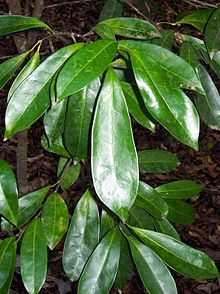Fontainea australis
| Fontainea australis | |
|---|---|
 | |
| Conservation status | |
| Scientific classification | |
| Kingdom: | Plantae |
| (unranked): | Angiosperms |
| (unranked): | Eudicots |
| (unranked): | Rosids |
| Order: | Malpighiales |
| Family: | Euphorbiaceae |
| Subfamily: | Crotonoideae |
| Tribe: | Codiaeae |
| Genus: | Fontainea |
| Species: | F. australis |
| Binomial name | |
| Fontainea australis Jessup & Guymer | |
Fontainea australis is a rare[1] rainforest plant from eastern Australia. The common name is Southern Fontainea. It grows in sub tropical rainforest at low altitudes on basaltic alluvial soils. Distributed from the Wilsons River (New South Wales) to the Tallebudgera Valley in south eastern Queensland.[2]
Description
A shrub or small tree to 5 metres tall. Leaves are 6 to 9 cm long and 2 to 3.5 cm wide,[3] alternate on the stem. Reverse ovate or elliptic in shape with a long leaf tip, and narrow wedge shaped at the leaf base. The leaf stalk are between 5 and 21 mm long, swollen at both ends, and somewhat channelled. Small white flowers appear on panicles flowers December to January. The fruit matures in July, being a red fleshy ovate shaped capsule, 2.3 cm in diameter.
References
- ↑ http://www.environment.gov.au/biodiversity/threatened/species/pubs/24037-conservation-advice.pdf
- ↑ Floyd, A.G., Rainforest Trees of Mainland South-eastern Australia, Inkata Press 2008, ISBN 978-0-9589436-7-3 page 150
- ↑ "Fontainea australis". PlantNET - NSW Flora Online.
